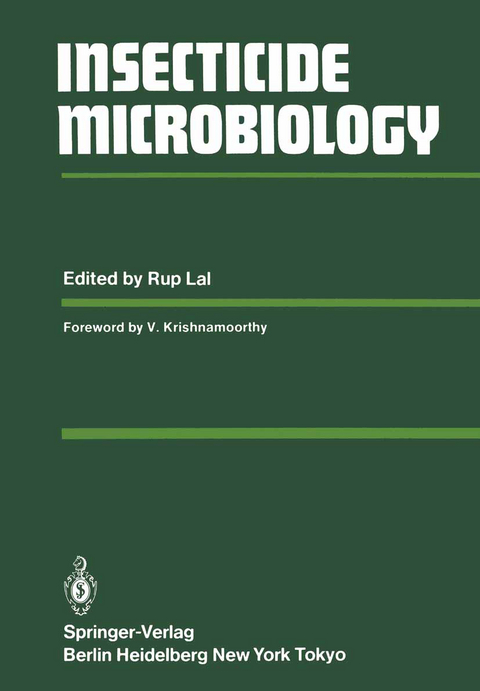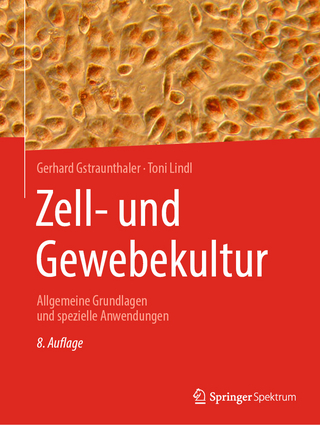
Insecticide Microbiology
Springer Berlin (Verlag)
978-3-642-69919-1 (ISBN)
1 Introduction.- 2 Insecticides and Microbial Environments.- 1 Introduction.- 2 Classification of Insecticides.- 3 Microbial Environments.- 4 Entry and Dispersal of Insecticides in Microbial Environments.- References.- 3 Experimental, Methodological and Analytical Approach to the Study of Microbe-Insecticide Interactions.- 1 Introduction.- 2 Accumulation.- 3 Metabolism.- 4 Analytical Implications.- 5 Effects.- References.- 4 Microbial Accumulation of Insecticides.- 1 Introduction.- 2 Quantitative Aspects.- 3 Bioconcentration.- 4 Bioconcentration Factors and Biomagnification.- 5 Patterns of Accumulation.- 6 Factors Affecting Microbial Accumulation of Insecticides.- 7 Mechanisms of Accumulation.- 8 Conclusions and Future Prospects.- References.- 5 Metabolism of Insecticides by Microorganisms.- 1 Introduction.- 2 Adaptation and Enrichment Techniques.- 3 Organophosphates.- 4 Dithioates.- 4.1 Azinophosmethyl (Gusathion).- 4.2 Malathion.- 5 Carbamates.- 6 Organochlorines.- 7 Pesticide Combination.- 8 Microorganisms and Pesticide Waste Treatment.- 9 Conclusions.- References.- 6 Enzymes Associated with the Microbial Metabolism of Insecticides.- 1 Introduction.- 2 Fundamental Reactions of Insecticide Metabolism.- 3 Organophosphates.- 4 Carbamates.- 5 Miscellaneous Enzyme Reactions.- 6 Discussion.- 7 Directions and Goals.- References.- 7 Genetic Engineering and Biological Detoxification/Degradation of Insecticides.- 1 Introduction.- 2 Insecticides, Microbes and Enzymes.- 3 Cellular Location of Detoxification/Degradation Genes.- 4 Genetic Engineering.- 5 Conclusion.- References.- 8 Effects of Insecticides on Soil Microorganisms.- 1 Introduction.- 2 Soil Microbial Populations.- 3 Ammonification.- 4 Nitrification.- 5 Denitrification.- 6 Biological Nitrogen Fixation.- 7 Respiration.-8 Soil Enzymes.- 9 Plant Pathogenic Microflora.- References.- 9 Effects of Insecticides on Algae.- 1 Introduction.- 2 Direct Effects.- 3 Factors Influencing Microbe/Insecticide Interactions.- 4 Secondary Effects.- 5 Conclusions and Future Prospects.- References.- 10 Cytological and Biochemical Effects of Insecticides on Microorganisms.- 1 Introduction.- 2 Cell Membranes.- 3 Energy Production, Enzymes and Metabolic Pathways.- 4 Nucleic Acids and Protein Synthesis.- 5 Photosynthesis.- 6 Cell Morphology.- 7 Conclusions and Future Prospects.- References.
| Erscheint lt. Verlag | 8.12.2011 |
|---|---|
| Vorwort | V. Krishnamoorthy |
| Zusatzinfo | XVI, 270 p. |
| Verlagsort | Berlin |
| Sprache | englisch |
| Maße | 170 x 244 mm |
| Gewicht | 507 g |
| Themenwelt | Naturwissenschaften ► Biologie ► Mikrobiologie / Immunologie |
| Schlagworte | Biology • ecotoxicology • Microbiology • Microorganism • Pesticides • Protozoa |
| ISBN-10 | 3-642-69919-7 / 3642699197 |
| ISBN-13 | 978-3-642-69919-1 / 9783642699191 |
| Zustand | Neuware |
| Haben Sie eine Frage zum Produkt? |
aus dem Bereich


